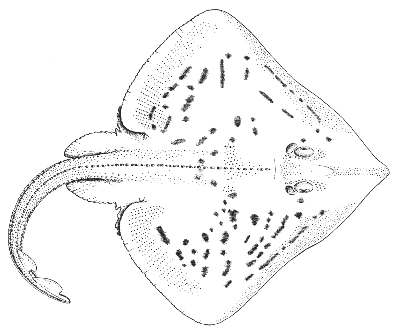Brier skate Raja eglanteria Bosc 1802
[Bigelow and Schroeder, 1953, p. 165.]
[Garman, 1913, pl. 23.]

Figure 27.—Brier skate (Raja eglanteria), female, about 29 inches long, Woods Hole, Massachusetts. From Bigelow and Schroeder. Drawing by E. N. Fischer.
Description—
In the brier skate, as in the thorny skate, the midline of the back and tail is armed with a continuous row of stout thorns from the shoulders to the first dorsal fin near the tip of the tail, usually with 1 or 2 in the gap between the 2 dorsal fins. But the thorns of this row are not much larger than those along the sides of the tail (they are in the thorny skate), and there are at least 16 thorns in the midrow along the tail (not more than 9 to 10 in the thorny skate). There also are groups of large thorns opposite and behind the eyes, with 1 to 5 on each shoulder and 1 to 4 rows along either side of the tail. Elsewhere the upper surface of the disc bears only small sharp prickles (hence its name), most numerous on the forward parts of the pectorals, over head and snout, and along the middle of the back and tail among the larger thorns. Thus it is a much smoother species than the thorny skate, and its snout is more acute, its outline being about a right angle with the margins bulging less opposite the eyes than in any of the blunter-nosed skates. The outer corners of the pectorals are distinctly angular, and the dorsal fins are separated by a short gap.
Color—
Brownish to grayish above; the pectorals variously marked with darker spots and blotches and with more elongate bars; this last is a characteristic feature; there is a translucent space on each side of the snout; it is white below. It is most readily recognized by its color pattern, with short dark bars as well as spots, which is not shared by any other Gulf of Maine skate.
Size—
The brier skate ordinarily grows to a length of about 2½ feet. The largest on record was about 37 inches long.
General range—
Off the eastern coast of the United States from Massachusetts Bay to both coasts of Florida.
Occurrence in the Gulf of Maine—
This is a southern species, uncommon even as far north as Woods Hole and decidedly rare in the Gulf of Maine. It has been recorded once from Gloucester, its most northerly outpost, and also from [page 66] Provincetown. Two specimens were taken on Nantucket Shoals near Round Shoal buoy by the Halcyon, one in July, the other in September, in 1924.